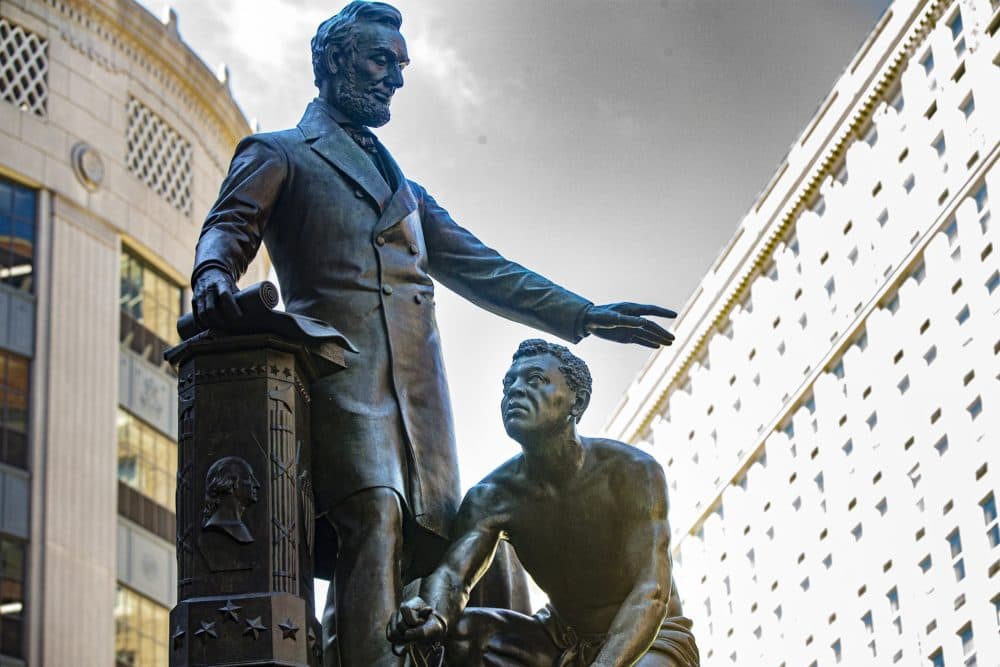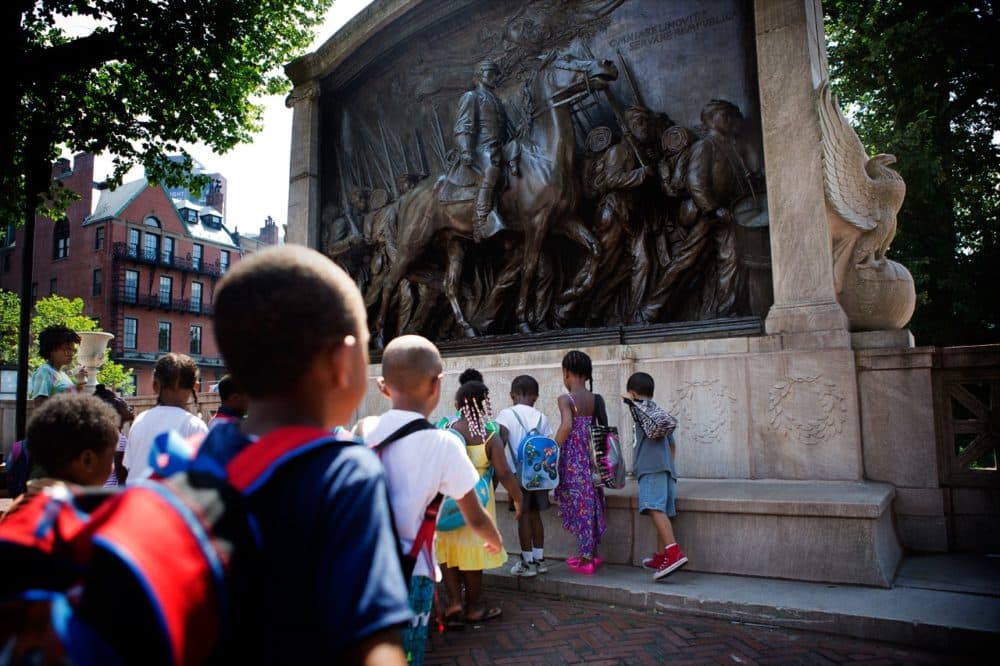Advertisement
Commentary
Black Bostonians Fought For Freedom From Slavery. Where Are The Statues That Tell Their Stories?

It was just a matter of time before the monument debate that has swept across the country, since the police killing of George Floyd in Minneapolis last month, arrived in Boston.
Last week, Dorchester native Tory Bullock posted a video on his Facebook page calling for the removal of the Emancipation Memorial or Freedman’s Memorial on Park Square. The memorial — a copy of the original designed by Thomas Ball, dedicated in Washington, D.C. on April 14, 1876 and paid for by formerly enslaved people — depicts Abraham Lincoln standing over a kneeling slave beckoning him to rise to claim his freedom. Bullock has already caught the attention of Mayor Marty Walsh, who is open to relocating the memorial.
In the video, Bullock expresses frustration with the “Black dude on his knees” — a popular motif within abolitionist circles before the Civil War. Bullock asks, “Does that make you feel powerful? Does that make you feel respected? Does that make you feel good?”
He is not the first African American to express such concern with the depiction of the Black man in this memorial or the narrative of emancipation that it represents.
Abolitionist Frederick Douglass served as the keynote speaker at the D.C. dedication. In front of thousands of Black residents and much of the federal government, including President Ulysses S. Grant, Douglass declared, “my white fellow-citizens…you are the children of Abraham Lincoln. We are at best only his stepchildren; children by adoption, children by force of circumstances and necessity.” Douglass fought too hard and for too long to fall in line with the image of Lincoln as the “Great Emancipator.”
Although Douglass never referenced the enslaved man in his speech, modeled after Archer Alexander, he is reported to have objected privately by suggesting, “it showed the negro on his knee when a more manly attitude would have been indicative of freedom.”
Even the most generous reading of the memorial ultimately falls short. “In bronze, Archer Alexander can never rise and stand, never come to consciousness of his own power,” writes historian Kirk Savage. “The narrative remains frozen in place, the monument perpetuating its image of racial difference for eternity.”
Douglass, Bullock and Savage highlight the inadequacies that many people have acknowledged over the years. It places African Americans in a submissive posture, who simply waited for the gift of emancipation from Lincoln and the rest of the nation rather than claiming it for themselves. It runs roughshod over the steps that enslaved men and women took throughout the war to undercut the Confederacy from within by running away from plantations as well as the service of roughly 200,000 Black men in the United States army.
The memorial itself deserves a serious review and public discussion, but it also highlights a glaring omission...
By the time the Emancipation Memorial was dedicated in Boston in 1879, African Americans — many of them formerly enslaved — were already standing on their two feet and engaged in political action in former Confederate states. They served in state legislatures and in Congress, where they pushed for a progressive platform that included the establishment of public schools, the redistribution of land and the expansion of voting rights. They did this in the face of brutal violence at the hands of terrorist groups like the Ku Klux Klan.
The memorial itself deserves a serious review and public discussion, but it also highlights a glaring omission on Boston’s downtown commemorative landscape that so far has gone unnoticed. Just two blocks from the Emancipation Memorial visitors and residents of the city can walk through the Public Garden, which includes numerous statues celebrating the city's white abolitionist leaders, such as William Ellery Channing, Wendell Phillips and Charles Sumner. William Lloyd Garrison, editor of the abolitionist newspaper The Liberator, is also located nearby on Commonwealth Avenue.
Lost in all of this is any sense that Black Bostonians crusaded for their own freedom. Before the Civil War, the north slope of Beacon Hill was a vibrant and politically engaged African-American community and one of the most important centers of Black abolitionism. Black abolitionists such as Lewis Hayden, William Cooper Nell, William Wells Brown, David Walker, Maria Stewart and Eliza Ann Gardner campaigned for the desegregation of Boston’s public schools, stood up to the federal government in the 1850s in defense of fugitive slaves and demanded the end of slavery. Their efforts culminated in Lincoln’s decision to issue the Emancipation Proclamation in 1863 and the recruitment of Black soldiers in the United States army in 1863 — a story that is beautifully commemorated in the memorial to Colonel Robert Gould Shaw and the men of the 54th Massachusetts Volunteer Infantry, located just across from the State House.

Like the kneeling slave in Thomas Ball’s memorial, the absence of statues commemorating these men and women leaves visitors with the impression that African Americans contributed nothing to their own emancipation. Rather, these statues reinforce the myth that emancipation was a gift from white Americans. According to historian Manisha Sinha, “Black abolitionists were integral to the broader, interracial milieu of the movement. To read them out of the abolition movement is to profoundly miss the part they played in defining traditions of American democratic radicalism.”
Contrary to the image of the kneeling slave, these men and women did not wait passively for the "Day of Jubilee." They led the charge.
Today, the stories of Boston’s Black abolitionists are told in the African Meeting House, run by the Museum of African American History and the National Park Service, for those visitors willing to stray from the more popular Freedom Trail. Contrary to the image of the kneeling slave, these men and women did not wait passively for the "Day of Jubilee." They led the charge.
Our commemorative landscape in the heart of Boston should reflect this important truth. More importantly, it needs to reflect the history of all Bostonians if only so we can chart a better path forward together.
It’s time for a conversation.
